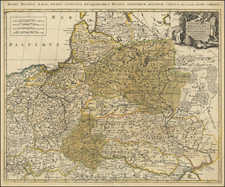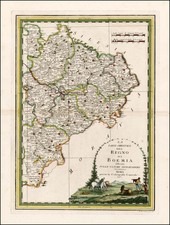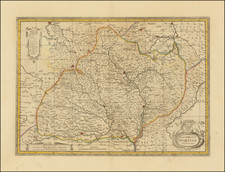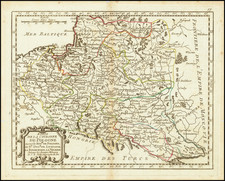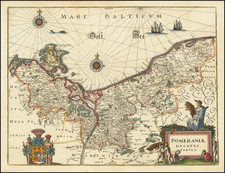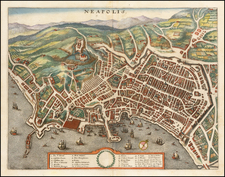"An Extraordinary Contribution to Holocaust Research" - Sir Martin Gilbert
The First Attempt to Map the Holocaust -- Mapping the Implementation of the Final Solution.
Map number three from Edward Kossoy's exceptional four-map series of the geography of the Holocaust. Kossoy's works being the first attempt to comprehensively map the Holocaust.
The sheet is composed of a large map of Eastern Europe from Estonia to the Sudetenland. The primary focus of the map is to illustrate the prosecution of the end stages of the "Final Solution" whereby smaller camps and ghettos throughout Eastern Europe were closed and their prisoners transferred to the large-scale extermination camps of Auschwitz, and then from Auschwitz transferred farther West to camps in Germany and elsewhere.
The map presents important data about the effect of the German military and territorial losses on the implementation of the Final Solution.
The inset map "Räumung des KZ-Auschwitz" | Evacuation of the Auschwitz Concentration Camp) shows movements of prisoners to and from Auschwitz in late 1944 and early '45.
Edward Kossoy
Edward Kossoy was a Polish lawyer, Irgun fighter, and advocate for victims of Nazism. Kossoy's family and life in Poland were utterly destroyed by the machinations of Nazi Germany and the USSR; after fleeing the German invasion of Poland, Kossoy was arrested by a Soviet militia and eventually charged by the NKVD with espionage and counter-revolutionary activities. He was imprisoned in a gulag until 1941 when he was freed by the Sikorski–Mayski Agreement. He evacuated the Soviet Union with the Anders Army to Tehran. His father, wife, and daughter were murdered by Nazi forces.
By 1944, Kossoy was in the British Mandate of Palestine, and soon he was active in Irgun and the Israeli War of Independence. He left Israel for Europe in 1954, where he earned his Ph.D. in law and political science. He then settled in Munich and began on his lifework, writing about the Holocaust and representing 60,000 of its victims.
Kossory died in 2012, in Switzerland at the age of 99.
Sir Martin Gilbert, author of the Atlas of the Holocaust, wrote of the importance of Kossoy's maps in starting him on his project:
In 1958, in Munich, an extraordinary contribution to Holocaust research was completed by Edward Kossoy. It consisted of only three pages: three single-sheet maps. The first showed the deportation routes with dates and numbers, from Austria, Slovakia, Bukovina, Ruthenia, Transylvania, Banat, Bacska, and Serbia, with an inset map showing concentration camps, labour camps, and internment camps in Italy. The second sheet showed concentration camps and labour camps throughout Poland, with inset maps showing camps in France, Transnistria, North Africa, Upper Silesia, and the Warsaw region. The third sheet showed concentration camps, slave labour camps, and 11 deportation routes, with dates and numbers, in the General-Government, the Baltic States, Upper Silesia, Danzig West-Prussia, East Prussia, and the Wartheland.
These three single-sheet maps were the first publications to show the scale of the deportations and the concentration and labour camp system. Kossoy’s work inspired me twenty years later as I began work on my 316-map Atlas of the Holocaust. Kossoy also published in 1958 a handbook which included camp tattoo numbers and the regional origin of the deportees to Auschwitz, a list of displaced persons camps after 1945, and the date of the Jewish holy days during the war: this latter a crucial guide, as so many survivors date an event by its fast or festival: for example Purim 1941, Passover 1942, the Day of Atonement 1943, or Hannukah 1944.
While Sir Martin wrote that Kossoy did three maps (we have only three maps), a record in the Archival Collections of the Jewish Family and Children's Services Holocaust Center reports four maps: "Map 1: Polanen, Frank.., Nord Africa; Map 2: MittelEuropa; Map 3: Polen and Balticum; Map 4: Donaurum and Italia."
Rarity
Rare. We have located no copies of Kossoy's maps at auction nor in dealer catalogs and only one set in a library collections, at the Bavarian State Library (OCLC 162252975), and one at the Jewish Family and Children's Services Holocaust Center.
Conclusion
Kossoy's self-published map is a font of information about the Holocaust and the practical networks through which it was prosecuted. The Holocaust was addressed again cartographically in Sir Martin Gilbert's Atlas in its various editions, but to this day, Kossoy's map series stands as an unparalleled accomplishment and an indispensable resource for the history of the 20th century.
Appendix: Translation of Key
- Vernichtungslager | Extermination camp
- Konzentrationslager | Concentration camp
- Polit. Grenzen vor 31.XII.1937 | Polit. borders before 31.XII.1937
- Provinzen und Provinzgrenzen während der deutsch. Besetzung. | Provinces and provincial borders during German. Occupation.
- Bezirke und Bezirksgrenzen während der deutsch. Besetzung. | Districts and district boundaries during the German. Occupation.
- [Meanings of symbols and font colors] Krakow am 19.1.45 befreit, am 6.VIII.44 - 10.000 Frauen von KZ-Plaszow per Eisenbahn nach dem KZ-Auschwitz evakuiert, vom 7.-10.VIII.44 - 5.000 Männer vom KZ-Plaszow nach KZ-Mauthausen per Eisenbahn evakuiert, am 5.I.45 - Frauentransport per Fuss vom KZ-Plaszow in Richtung Ravensbrück. | Krakow released on 19.1.45, on 6.VIII.44 - 10,000 women moved from KZ-Plaszow by train to KZ-Auschwitz, from 7.-10.VIII.44 - 5.000 men from KZ-Plaszow to KZ-Mauthausen moved by railway, on 5.I.45 - transport of women by foot from KZ-Plaszow in the direction of Ravensbrück.
- Seetransporte | Sea transport
- [Meanings of symbols and font colors] Lodz am 19.I.45 befreit, wobei 870 Häftlinge lebend gefunden wurden. | Lodz was liberated on 19.I.45, 870 prisoners being found alive.
- [Meanings of symbols and font colors] 2,500 Häftlinge des KZ-Wilno am 2.VII.44 hingerichtet. | 2,500 prisoners of the concentration camp Wilno executed on 2 .VII.44.
Edward Kossoy was a Polish lawyer, publicist and an activist for victims of Nazism.
Kossoy was born in Radom. His family moved to Yekaterinoslav, Ukraine during World War I. After the Polish-Soviet War and the Peace of Riga in 1921, Kossoy's family returned to Poland.
Kossoy attended the Tytus Chałubiński National Gymnasium in Radom and then studied at the Law School of Warsaw University, graduating in 1934.
During the Nazi invastion of1939, Kossoy fled from Warsaw to Lviv. When Lviv was taken by Soviet Russia following the invasion of Poland, Kossoy planned to locate his family in Lviv while he traveled to France via Romania to join the Polish army, which was then forming in France. However, he was arrested by the Soviet militia, charged with smuggling watches he was trying to sell to raise money for his family and for travel to France. During interrogation he admitted to having had a higher education and was handed over to the NKVD which charged him with espionage and "counter-revolutionary activity".
He was sentenced to eight years in the Gulag and sent to the sub-camp Vorkuta, Pechora, where he worked on the construction of the railway which connected the mouth of the Pechora River with the southern end of the Urals. According to Kossoy, of the 20,000 Poles who arrived at the camp in 1941, only 6,000 were alive two years later. He was released after two years because of the Sikorski–Mayski Agreement, leaving the Soviet Union with the Anders Army.
During World War II, Kossoy's, father, wife and daughter were murdered by the Germans as part of Operation Harvest Festival.
He was officially discharged from the Anders Army in 1943 in Teheran. By late 1943 he was in the British Mandate of Palestine. In Tel Aviv in 1944, he wrote and published a series of essays, Stołypinka (named after the rail cars used to transport prisoners to the gulag), based on his experiences, which remained unpublished in book form until 2003.
In Palestine, Kossoy joined the Irgun., In 1948, fought with the Irgun during the War of Independence.
Kossoy remained in Israel until 1954, before returning to Germany, where he studied in Munich andCologne and later in Switzerland, at the Graduate Institute of International Studies in Geneva, where he obtained a Ph.D. in law and political science.
In Geneva he began his long time association with Wacław Micuta, a former member of the Polish Home Army and a United Nations staff member. Micuta was the first to inform Kossoy about the liberation of the Gęsiówka concentration camp by Polish resistance during the Warsaw Uprising. At first Kossoy was skeptical, but he decided to investigate the matter farther and located some survivors of the camp among his clients, who confirmed Micuta's story. Kossoy wrote several historical articles on the subject, which were published by Yad Vashem and in the Polish emigre press (with the help from Jerzy Giedroyc).
As an attorney, he represented around 60,000 victims of the Holocaust, involving restitution and reparations from the German government. His clients included Jews, Poles and Romani.
Kossoy published several books in various languages (English, German and Polish) and historical articles related to restitution for Nazi crimes, contemporary international relations and Polish-Jewish dialogue. Many were published in Zeszyty Historyczne (Historical Journals), published by the Literary Institute of Paris. His memoirs, entitled On the Margin..., were published in 2006, and nominated for the Nike Award in 2007.
At the time of his death he was an honorary senator of the University of Tübingen.









